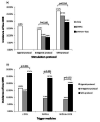Risk factors for low oocyte retrieval in patients with polycystic ovarian syndrome undergoing in vitro fertilization
- PMID: 37468927
- PMCID: PMC10355040
- DOI: 10.1186/s12958-023-01118-1
Risk factors for low oocyte retrieval in patients with polycystic ovarian syndrome undergoing in vitro fertilization
Abstract
Background: The number of oocytes retrieved does not always coincide with the number of follicles aspirated in in vitro fertilization/intracytoplasmic sperm injection (IVF/ICSI) treatment. Patients with high expectation of retrieval sometimes obtain few oocytes, which may be induced by improper operation or therapeutic factors. The purpose of this study was to evaluate the distribution data of oocyte retrieval rate (ORR) and to explore the risk factors for low ORR in patients with polycystic ovary syndrome (PCOS) undergoing IVF/ICSI.
Methods: A total of 2478 patients with PCOS undergoing IVF/ICSI were involved in this retrospective case-control study from March 2016 to October 2021. The oocyte retrieval rate was calculated as the ratio of the number of obtained oocytes to the number of follicles (≥ 12 mm) on the trigger day. Patients were divided into a low ORR and a normal ORR group with the boundary of one standard deviation from the mean value of ORR. The patient characteristics, treatment protocols, serum hormone levels, and embryonic and pregnancy outcomes were analyzed.
Results: The ORR exhibited a non-normal distribution, with a median of 0.818. The incidence of complete empty follicle syndrome was 0.12% (3/2478). The proportion of patients in the low ORR group who received the progestin-primed protocol was significantly higher than that in the normal ORR group (30.30% vs. 17.69%). A logistic regression analysis showed that the serum estradiol level/follicle (≥ 12 mm) ratio (OR: 0.600 (0.545-0.661)) and progesterone level (OR: 0.783 (0.720-0.853)) on the trigger day were significant factors in the development of a low ORR, with optimal cutoff values of 172.85 pg/ml and 0.83 ng/ml, respectively, as determined by receiver operating curve. Fewer high-quality embryos (2 vs. 5) and more cycles with no available embryos (5.42% vs. 0.43%) were found in the low ORR group.
Conclusions: For patients with PCOS, low estradiol levels/follicles (≥ 12 mm) and progesterone levels on the trigger day and the use of the progestin-primed protocol could be risk factors for low ORR, which leads to a limited number of embryos and more cycle cancellations.
Keywords: In vitro fertilization; Oocyte; Polycystic ovary syndrome; Risk factor.
© 2023. The Author(s).
Conflict of interest statement
The authors declare no competing interests.
Figures



Similar articles
-
Influencing factors and effects of low oocyte retrieval in patients with polycystic ovary syndrome undergoing in-vitro fertilization.Eur J Obstet Gynecol Reprod Biol. 2025 Jan;304:97-103. doi: 10.1016/j.ejogrb.2024.11.028. Epub 2024 Nov 22. Eur J Obstet Gynecol Reprod Biol. 2025. PMID: 39608208
-
[Effects of dyslipidemia on IVF/ICSI pregnancy outcome in patients with polycystic ovary syndrome].Zhonghua Fu Chan Ke Za Zhi. 2018 Jun 25;53(6):402-408. doi: 10.3760/cma.j.issn.0529-567x.2018.06.008. Zhonghua Fu Chan Ke Za Zhi. 2018. PMID: 29961283 Chinese.
-
Serum steroid metabolome on the day of oocyte retrieval in women with polycystic ovarian syndrome and its association with pregnancy outcome of in vitro fertilization.J Steroid Biochem Mol Biol. 2023 Jul;231:106311. doi: 10.1016/j.jsbmb.2023.106311. Epub 2023 Apr 13. J Steroid Biochem Mol Biol. 2023. PMID: 37060931
-
Conventional GnRH antagonist protocols versus long GnRH agonist protocol in IVF/ICSI cycles of polycystic ovary syndrome women: a systematic review and meta-analysis.Sci Rep. 2022 Mar 15;12(1):4456. doi: 10.1038/s41598-022-08400-z. Sci Rep. 2022. PMID: 35292717 Free PMC article.
-
Management of women with PCOS using myo-inositol and folic acid. New clinical data and review of the literature.Horm Mol Biol Clin Investig. 2018 Mar 2;34(2):/j/hmbci.2018.34.issue-2/hmbci-2017-0067/hmbci-2017-0067.xml. doi: 10.1515/hmbci-2017-0067. Horm Mol Biol Clin Investig. 2018. PMID: 29498933 Review.
Cited by
-
A Comprehensive Case Report on Managing PCOS-Related Infertility: Successful Pregnancy Achieved via Controlled Ovarian Stimulation and Intracytoplasmic Sperm Injection (ICSI).J Pharm Bioallied Sci. 2025 May;17(Suppl 1):S964-S967. doi: 10.4103/jpbs.jpbs_1916_24. Epub 2025 Apr 9. J Pharm Bioallied Sci. 2025. PMID: 40511078 Free PMC article.
-
Successful outcome of assisted reproductive technology in women with polycystic ovary syndrome combined with empty follicle syndrome: A case report.Medicine (Baltimore). 2025 Jun 27;104(26):e43001. doi: 10.1097/MD.0000000000043001. Medicine (Baltimore). 2025. PMID: 40587668 Free PMC article.
References
-
- Gallot V, Berwanger da Silva AL, Genro V, Grynberg M, Frydman N, Fanchin R. Antral follicle responsiveness to follicle-stimulating hormone administration assessed by the follicular output RaTe (FORT) may predict in vitro fertilization-embryo transfer outcome. Hum Reprod. 2012;27(4):1066–72. doi: 10.1093/humrep/der479. - DOI - PubMed
MeSH terms
Substances
Grants and funding
LinkOut - more resources
Full Text Sources
Medical

